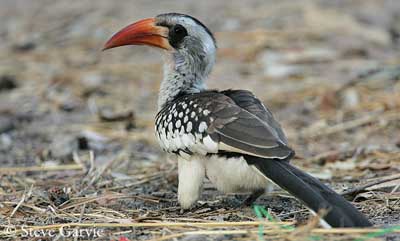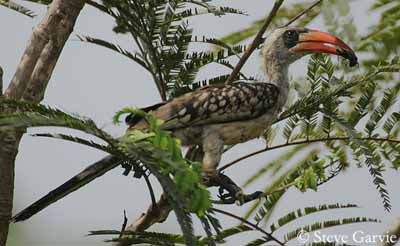
Red-billed Hornbill
Tockus erythrorhynchus
Bucerotiforme Order – Bucerotidae Family
BIOMETRICS:
Length: 50 CM
LONGEVITY: Up to 18 years
DESCRIPTION:
Red-billed Hornbill has whitish head and underparts. We can see a sooty-black stripe on forehead, extending over crown, finishing to a point on the back. Back is dark brown with white stripe down centre. Wings are dark brown with conspicuous white patches. Long tail is dark brown, with white edges. Stubby legs and feet are brownish black.

PROTECTION / THREATS / STATUS:
Red-billed Hornbill has predators, such as large raptors and adders. They may be locally abundant. They are popular zoo and aviary birds, but they do not breed in captivity.
Fr: Calao à bec rouge
All : Rotschnabeltoko
Esp : Toco Piquirrojo
Ital : Bucero Beccorosso
Nd : Roodsnaveltok
Photographers:
Steve Garvie
RAINBIRDER Photo galleries
Callie de Wet
GALLERY
Text by Nicole Bouglouan
Sources:
HANDBOOK OF THE BIRDS OF THE WORLD Vol 6 by Josep del Hoyo-Andrew Elliott-Jordi Sargatal - Lynx Edicions, 2001 - ISBN: 848733430X
BIRDS OF AFRICA SOUTH OF THE SAHARA by Ian Sinclair and Peter Ryan - Princeton University Press Princeton and Oxford - ISBN: 0691118159
Wikipedia (Wikipedia, The Free Encyclopedia)

Bill is down curved, with typical orange-red mandibles, but it lacks casque.
Eyes are pale yellow-green, with long eyelashes.
Both sexes are similar. Female has smaller bill than male.
Juvenile is duller than adults, but similar. It has shorter and straighter bill than adults.
We can find 5 different races, according to the range:
T. erythrorhynchus – Northern Africa (South of Sahara).
T. damarensis – Endemic to South-West Africa (South of Sahara).
T. rufirostris – Endemic to South and Centre of Africa (South of Sahara)
T. ruahae – Endemic to Tanzania.
T. kempi – Endemic to West Africa.
VOICE: SOUNDS BY XENO-CANTO
Red-billed Hornbill utters clucks, such as “kok-kok-kok-kokok-kokok-kokok”, increasing in tempo and volume.
HABITAT:
Red-billed Hornbill frequents open woodlands and dry savannahs, thorn scrubs.
RANGE:
Red-billed Hornbill is common from Senegal to Ethiopia and Somalia, and southwards to Kenya and Tanzania. It is also found in South Africa, Botswana, Angola and Mozambique.

BEHAVIOUR:
Red-billed Hornbill is an opportunistic feeder. It feeds in pairs or in flocks of 40 to 80 birds, often in burnt areas or in paddy-fields after harvest. It will exploit any abundance of insects, grain and fruit. It runs on the ground, searching for food.
It is a terrestrial bird, enjoying sunbathing!

Red-billed Hornbill is often seen in pairs, or in small family groups. During dry season, they may gather in large flocks of hundreds, around water holes and feeding areas. They move early in the morning, but they return to their regular roost in their territories at night. They roost in trees, on large branches or close to the trunk.
Red-billed Hornbill is territorial. It defends permanent territory against its own species, but not others. Generally, Hornbills have overlapping territories. They are sedentary.
Red-billed Hornbill runs rather than hops. It digs into the soil with its well adapted bill.

Courtship displays include “shoulder-shrugging” and ‘body-swaying”. Birds have opened wings and raised head. During displays, they utter clucking calls with bowed head and slightly opened wings. They are monogamous.
Female moults during her time into the nest. Feathers re-grow when she emerges.
FLIGHT:
Red-billed Hornbill flies with a flap-and-glide flight.
REPRODUCTION:
Red-billed Hornbill nests in natural tree cavity. Female is sealed up for 2 or 3 months, during incubation and after hatching. Male feeds her through a small slit. Female seals herself the entrance, using mud and her own droppings, mixed with food remains. She makes a narrow vertical slit, to be fed by the male.

Female lays 3 to 5 eggs. Incubation lasts about 23 to 25 days, by female. She breaks out of the nest, when the oldest chick reaches 21 to 22 days of age. At this time, she goes out, and chicks reseal the entrance. They use their droppings and food remains.
Young remain in the nest one and half month more, fed by both parents. They remain with parents for about six months. Young reach their sexual maturity between 1 and 3 years of age. It depends of their size.
DIET:
Red-billed Hornbill feeds mainly on insects (beetles, grasshoppers, termites) and flies larvae. It also eats bird’s eggs and nestlings, and geckos (a kind of lizard). It may scavenge dead rodents.
